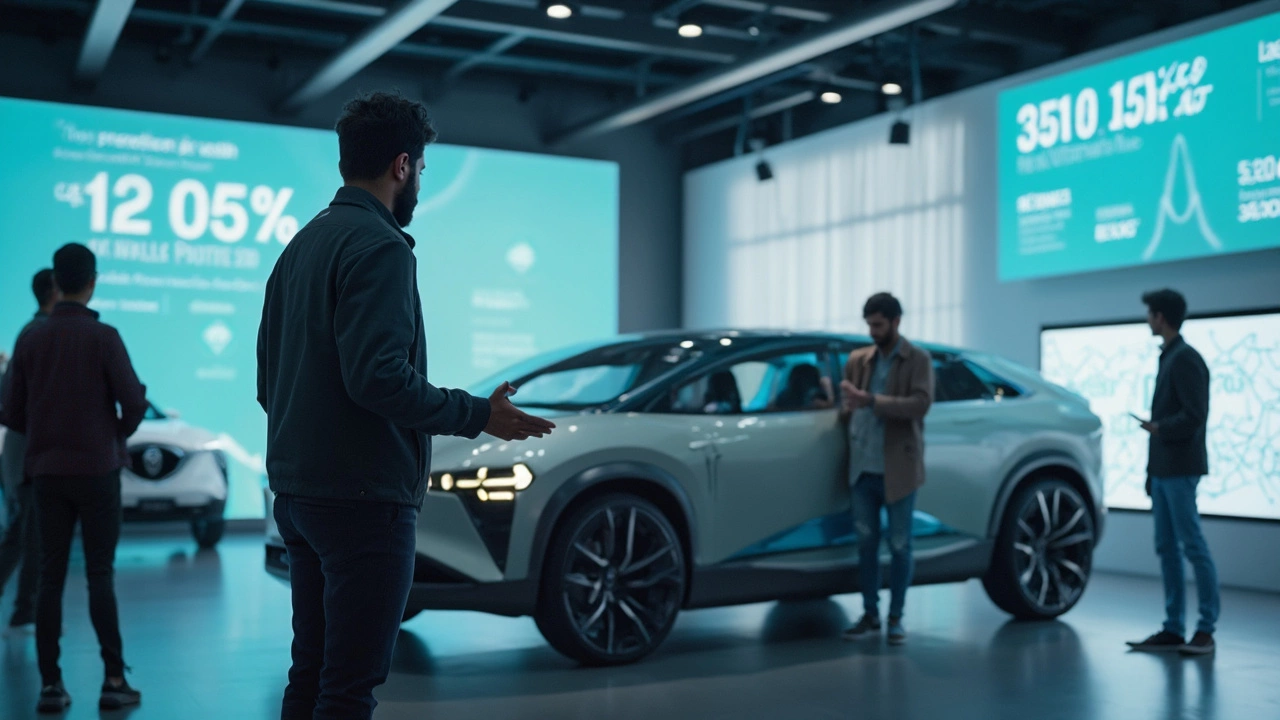Take a quick drive across the States and you’ll spot cars from Korea, Japan, and even China these days—but finding one built by an Indian company? That's more like a rare wildlife sighting. Indian automakers are huge back home and across Africa and Asia, but the American market is a whole different beast. Folks often ask: Are there any real Indian cars on sale in the USA, or is it just a rumor?
The truth? You’ll hunt long and hard to find anything with a Tata or Mahindra badge at your local dealership. Still, there have been attempts, surprise entries, and even some backdoor wins. If you’re curious how Indian engineering tried to break into the American car world (and why it usually didn’t stick), you’re in the right place. Let's break down what really happened, who made it over, and what to watch for if you’re thinking of getting your hands on a made-in-India ride.
- Why Indian Cars Are Rare in the USA
- Mahindra: The Pickup and the EV Gamble
- Tata Motors and the Jaguar-Land Rover Factor
- Other Indian Brands and Experimental Models
- Practical Tips: Buying and Importing Indian Cars
Why Indian Cars Are Rare in the USA
Ever wondered why that shiny Indian cars badge is so hard to find at American dealerships? It’s not because Indian companies aren’t building enough vehicles. In fact, India is one of the world’s top car producers—cranking out more than 4 million cars per year, with a big chunk shipped overseas. But the American market comes with some hurdles you can’t just leap over with low prices and good intentions.
The first big wall is America’s crazy strict safety and emissions rules. What works on Indian roads often has to face big upgrades to even qualify for US streets. The National Highway Traffic Safety Administration (NHTSA) and the Environmental Protection Agency (EPA) have their own long lists of must-haves. For example, crash test standards here are no joke, and just passing Indian standards won’t cut it. The upgrades cost serious cash, and not every company is ready to spend that kind of money for a shot in a super-competitive market.
Then there’s the issue of brand recognition. Let’s be real—most Americans have never even heard of Mahindra or Tata. People want to buy cars from brands they trust, and dealers want names that bring in foot traffic. It’s not easy to start from zero, and car companies hate burning cash on big ad campaigns just for the brand introduction phase.
Don’t forget big tariffs on imported trucks. The so-called “Chicken Tax” slaps a 25% tariff on light trucks and pickups coming from other countries. Back in 2010, Mahindra tried to dodge this by planning to assemble pickups in the USA, but a long legal battle and tricky logistics torpedoed their plans. Here’s how the numbers stack up:
| Barrier | Impact on Indian Cars |
|---|---|
| Safety & Emissions Rules | Major upgrades, expensive rework required |
| Lack of Brand Recognition | Low sales interest, hard for dealers |
| 25% Tariff on Trucks | Massively raises prices |
| Competition | US buyers love Japanese, Korean, & US brands |
Add a fierce love for homegrown vehicles and bargain-hunting shoppers who expect bulletproof reliability and customer service, and it’s easy to see why Indian brands have struggled here. It’s not impossible, just a huge mountain to climb.
Mahindra: The Pickup and the EV Gamble
When people talk about Indian cars in the USA, Mahindra is usually the first name that pops up. But here’s the catch: you won’t find their pickups or SUVs parked outside your favorite big box store—at least, not officially. Back in 2006, Mahindra made big waves by announcing plans to bring their diesel pickups and SUVs to America. They hyped the TR20 and TR40 pickup trucks: diesel-powered, tough, and supposedly good on gas. Dealers signed up all over the country, and some even took customer deposits. What happened next? Let’s just say, plans fizzled out fast. The trucks never got past the heavy US emissions and crash safety rules. Lawsuits followed, and buyers who were waiting got nothing but a lesson in patience.
Mahindra did get a win, though, by going around the obvious roadblocks. In 2018, they launched the Roxor, a Jeep-style off-road vehicle. This thing looks a lot like an old Willys Jeep, but it skips all the paperwork by being a side-by-side UTV instead of a regular street car. It’s an oddball move but smart in its own way—no need to meet highway rules if you’re not meant for the highway.
The Roxor’s impact? Check out these numbers for a sense of how Mahindra’s U.S. footprint compares to mainstream brands:
| Year | Roxor Sales (Estimate) | Ford F-Series Sales |
|---|---|---|
| 2019 | ~3,500 | 896,526 |
| 2022 | ~2,700 | 653,957 |
As you can see, Mahindra is playing in a different league—more like a niche playground than the NFL. But if you want something unique off-road, Roxor is about the closest you’ll get to a true Indian car experience in the USA.
What about electric vehicles? Mahindra tossed their name in the hat with talk about bringing compact EVs to the States, especially through their GenZe brand. GenZe made electric scooters and small cargo vehicles; you could find them in a handful of cities as delivery or campus rides. But by 2020, Mahindra pulled the plug on GenZe’s U.S. operation—blame it on tough competition and a market that wasn’t ready for quirky EVs from India. If anything changes, it will probably start with something small, city-friendly, and all-electric. But right now, Mahindra’s American dream mostly lives in off-road parks and daydreams.

Tata Motors and the Jaguar-Land Rover Factor
Ask anyone in the U.S. about Indian cars and you’ll probably get a blank stare—unless they realize that their fancy new Jaguar or rugged Land Rover is actually made thanks to Tata Motors. Yep, the biggest headline grab by an Indian car maker on American soil didn’t come from a Tata-branded car, but from a shocking buyout. In 2008, Tata Motors, one of India’s top automakers, bought the iconic British brands Jaguar and Land Rover from Ford for $2.3 billion. That move didn’t just shake up the luxury car world—it quietly changed what was rolling out in U.S. dealerships.
Let’s clear something up: Tata doesn’t sell any cars under the Tata badge in the USA. You won’t see a Tata Nano zipping down LA freeways or a Tata Safari at a Texas rodeo. What you do see—especially in the luxury or SUV game—are Jaguars and Land Rovers, engineered and funded under Tata’s ownership. Tata invested millions to clean up Jaguar-Land Rover’s operations, boosted quality, and helped them churn out new models that really clicked with American tastes.
Just look at the numbers. Since Tata took over, sales for Jaguar Land Rover in North America have stayed strong. Check out this table showing U.S. retail sales for Land Rover and Jaguar since Tata’s buyout:
| Year | Jaguar Sales | Land Rover Sales |
|---|---|---|
| 2010 | 13,340 | 31,864 |
| 2015 | 14,466 | 70,582 |
| 2020 | 21,786 | 80,211 |
| 2023 | 14,249 | 68,965 |
If you’re wondering why Tata Motors hasn’t tried to sell its own models here, it comes down to strict safety and emissions rules, plus the tough competition. The Nano might be an icon in India, but it wouldn’t stand a chance against cars Americans actually want to drive. Instead, Tata’s focus in the U.S. has been to keep Jaguar and Land Rover growing strong. Fun fact: while your Range Rover might look and feel like British luxury, it owes a lot to Indian money and business smarts.
Bottom line—if you want a true Indian-built car in your U.S. driveway, it’s not happening yet. But if you want a glimpse of Indian auto influence in your garage, just check the badge on your next British SUV.
Other Indian Brands and Experimental Models
If you dig into the past decade, you'll see a handful of Indian automakers showing up in the US news—at least for their quirky experiments. Most Indian car brands never officially made it into mainstream car lots, but a few did try some creative angles.
Take Reva, for example. It’s a name that didn’t get much attention here, but their little electric hatchback, the Reva G-Wiz, was actually spotted in California during the early 2010s. It wasn't sold widely—mainly, you saw test models and early rally demos. After Mahindra bought Reva, their upgraded e2o models had some demo imports, but never reached actual sales due to missing basic US crash test standards. Those cars, while big in Bangalore, just didn’t pass American safety red tape.
Force Motors looked at commercial opportunities. They explored low-volume van exports for specific uses—think airports and industrial campuses—but you couldn’t just walk into a dealership and buy one. These vehicles landed under special import rules for fleets, not regular drivers. They were mostly workhorses, not family haulers.
Then there are small setups like DC Design. They build super-custom cars and tried showing off concepts in Las Vegas auto shows, hoping to catch an American audience hungry for something weird. But these projects were more about hype than actual cars in driveways.
Check out the tiny numbers that prove this is all pretty niche:
| Brand/Model | Period | Type | Estimated US Presence |
|---|---|---|---|
| Reva G-Wiz | 2010-2012 | Electric | <100 vehicles (test/demo only) |
| Mahindra e2o | 2014-2016 | Electric | ~20 (compliance testing) |
| Force Traveler (van) | 2015-2017 | Commercial | Few dozen (fleet only) |
| DC Avanti | 2015 (concept) | Sports car | 0 (showcase only) |
If you’re hoping to cruise down Route 66 in anything from an Indian brand, your best chance is hunting auctions or collectors’ meets where one of these oddballs might turn up. For now, there’s Indian cars in the USA, but only in small numbers, mostly garage queens or conversation starters instead of daily drivers.

Practical Tips: Buying and Importing Indian Cars
Actually getting an Indian car onto American roads takes a bit more effort than just picking up the phone or shopping online. Even though you might want to be the only one on your street with wheels from Tata or Mahindra, U.S. rules make it tough. Let’s go through what you really need to know—and what’s flat-out impossible right now.
Indian cars mainly get blocked by U.S. safety, emissions, and crash-test rules. For example, almost no current models sent out from India have crash ratings that match up with strict U.S. standards. Most don’t have airbags or features that American buyers just expect, so dealerships can’t legally sell them—even if they wanted to.
Is there a work-around? Well, a few. You can import a car for “show or display” (think collector’s items), but you’re pretty much banned from just daily driving it if it’s less than 25 years old. After 25 years, the law loosens up a lot, and you can bring in just about anything—granted, you deal with a ton of paperwork.
"Most Indian cars don’t meet U.S. federal requirements for safety and emissions. That’s the main hurdle. If you want one as a novelty or a weekend toy, importing after 25 years is the only real option." — Dan Edmunds, car tech consultant (quoted in Car and Driver, 2022)
Let’s get specific. Here’s what you’ll need in most cases to import a car from India:
- Proof the car is at least 25 years old, if you want to register and drive it
- Detailed paperwork: bill of sale, foreign registration, shipping documents
- Filled EPA and DOT forms (forms 3520-1 and HS-7 matter most)
- Customs clearance and import taxes (these can be pricey!)
- Transportation or freight fees—shipping can run $1,500 to $3,000 depending on the port
Here’s a quick price comparison for those curious about costs (for a used/imported Mahindra Thar, for example):
| Cost Item | Estimated Price (USD) |
|---|---|
| Used Car (India Market) | $8,000 – $14,000 |
| Shipping + Insurance | $1,500 – $3,000 |
| Customs Duties | 2.5% – 25% (depending on type) |
| Admin/Paperwork | $500 – $1,000 |
Some folks get caught off-guard by state-level surprises. California, for example, has even stricter emissions rules than the national ones. Always check with your own DMV before spending a dime.
If you’re dead set on new Indian models, it’s usually smarter (and less risky) to wait for a version built for North America—like the odd Mahindra Roxor, which actually gets sold as an off-road UTV and isn’t street-legal, or luxury options through Tata's Jaguar-Land Rover.
Long story short: if you want true Indian wheels in the states, patience plus paperwork—or a big budget—is the way in. Always use a licensed importer, and double-check every regulation before pressing buy. There’s no easy shortcut, but hey, standing out can be worth the hassle.
